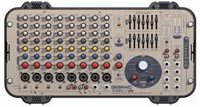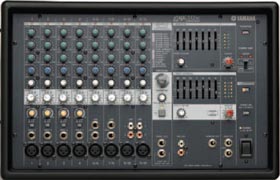Mixer Amplifiers

When most users think of a sound system, they think of the visible endpoints: microphone or the loudspeaker. But neither of these passive components can create any sound without active components between them. Microphone signals require a preamp, signal processing, and
amplification before the loudspeaker can do its job.
For small sound system requirements, there's nothing more convenient than combining some of these tasks into a single component, and that's where the mixer/amplifier (or powered mixer) really shines.
Mixer/amps are most commonly used by solo musicians, or for smaller venues such as clubs, coffee houses, and even school/church multi-purpose rooms. But they are equally useful in any building where a sound system might be temporarily set up in different rooms (or outdoors) on different days. In some cases, portable mixer/amps are even permanently installed, despite their ultra-portable nature.
ADVANTAGES AND DISADVANTAGES
Mixer/amplifiers usually combine a mixer, equalizer, and amplifier all into one unit. They typically range from six to 20 inputs, and up to 1,200 watts total power output.
For portable applications, the advantages are obvious. Most manufacturers provide units with built-in carrying handles to take full advantage of the compact size and feature combination. Since all three components are included, there is only one box to carry instead of three. There is also less set up required, since you don't need to interconnect the components.
A daily selection of features, industry news, and analysis for tech managers. Sign up below.
There are some disadvantages with powered mixers for permanent installations, however. For one thing, a high-quality mixer/amp can cost as much or more than its separate components. Also, if one part of the mixer/amp fails, you need to replace the entire unit in order to get your sound system up and running. And since the equalizer is always exposed (as opposed to being in a separately located rack somewhere), it is susceptible to tampering by unqualified (or curious) hands. Some of the more sophisticated features that are available on separate mixers may not available on mixer/amps (such as mute, subgroups,

more than two or three Auxiliary sends).
HOW TO CHOOSE A MIXER/AMP
Here are some of the more popular features, and the decision you need to make before choosing the right one for your application.
Mic/line/instrument inputs: How many microphones will you be using? Don't forget to include direct inputs from DVD players or musical instruments. And keep future expansion in mind.
Equalization: This can range from simple treble, mid, bass control to multi-band graphic or parametric equalizers. It depends on how much control over tone shaping or feedback you think you'll need.
Direct Outs/Inserts: If you'll be using external sound effect devices or other signal processing, you'll want input/output access to individual channels.
Onboard Effects: Some small mixer/amps include impressive builtin digital effects like delay and reverb.
Mono or stereo: Stereo amplifiers are important for high-quality music, but it's also useful for sending different output levels to each loudspeaker.
- Monitor outs: For musicians, separate monitor outputs can be essential. But it's also useful for sending signal to outboard amplifiers for control over multiple loudspeaker zones.
The AVNetwork staff are storytellers focused on the professional audiovisual and technology industry. Their mission is to keep readers up-to-date on the latest AV/IT industry and product news, emerging trends, and inspiring installations.
